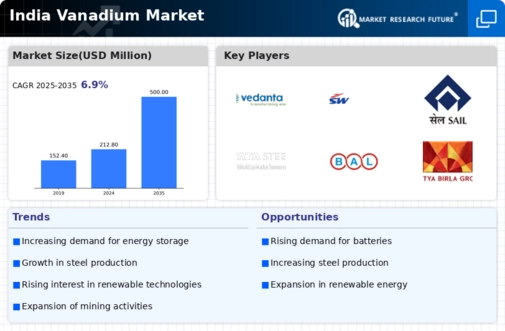The competitive landscape of the India Vanadium Market is characterized by a mix of entrenched players and emergent companies striving to carve a niche for themselves in this specialized sector. Vanadium, primarily used in steel production and as a component in vanadium redox batteries, is witnessing increased demand due to its applications in various high-tech and energy-efficient solutions. The market dynamics are influenced by factors such as pricing volatility, raw material availability, and the growing push for sustainable materials in industrial processes.
As manufacturers explore innovative processing techniques and efficient supply chain management, companies are actively engaging in strategic partnerships and investments to bolster their market position. The competitive environment is further shaped by governmental policies promoting infrastructure development and renewable energy initiatives, both of which are expected to boost vanadium consumption in the coming years. Vedanta Limited has established a prominent presence in the India Vanadium Market, leveraging its extensive experience and resources in the metal and mining sectors. The company is known for its commitment to quality and sustainability, which resonates well with the growing demand for responsibly sourced materials.
Vedanta Limited's strengths include its robust operational capabilities, advanced technologies, and a well-integrated supply chain that ensures consistent product availability. The company also emphasizes research and development to innovate its vanadium production processes, which enhances efficiency and reduces environmental impact. By focusing on strategic collaborations and expanding its market reach, Vedanta Limited is well-positioned to capitalize on the rising demand for vanadium within the country, making it a key player in this evolving market. JSW Steel is another significant contributor to the India Vanadium Market, distinguished by its commitment to high-quality steel production and innovative solutions.
The company integrates vanadium into its steelmaking processes, specializing in high-strength steel that caters to the automotive, construction, and infrastructure sectors. This integration provides JSW Steel with a competitive edge, optimizing the use of vanadium to enhance product performance. JSW Steel's robust market presence is bolstered by its ongoing investments in plant upgrades and capacity expansions aimed at increasing production efficiency. The company has also pursued various mergers and acquisitions, which have allowed it to broaden its product portfolio and enhance its operational capabilities.
Through a focus on quality, innovation, and sustainability, JSW Steel continues to strengthen its position in the Indian vanadium market, catering to the increasing demand driven by the burgeoning infrastructure projects and steel consumption in India.



















Leave a Comment